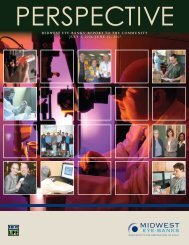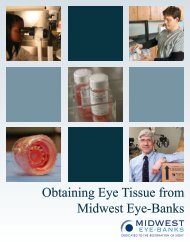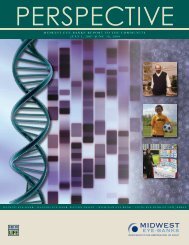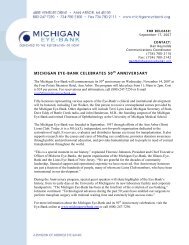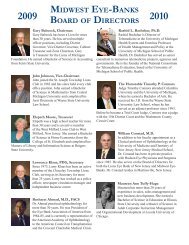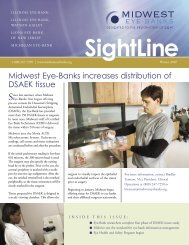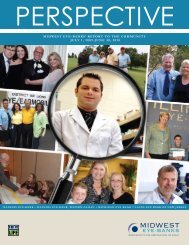2010 Guide - Michigan Eye Bank
2010 Guide - Michigan Eye Bank
2010 Guide - Michigan Eye Bank
You also want an ePaper? Increase the reach of your titles
YUMPU automatically turns print PDFs into web optimized ePapers that Google loves.
A <strong>Guide</strong> to the<br />
<strong>Michigan</strong> <strong>Eye</strong>-<strong>Bank</strong><br />
1
On the cover: Midwest <strong>Eye</strong>-<strong>Bank</strong>s’ Donor Memorial Garden is a place for donor family<br />
members and others to pay tribute to loved ones, and to reflect upon the gifts they<br />
have made possible. If you would like to support the <strong>Michigan</strong> <strong>Eye</strong>-<strong>Bank</strong> and honor<br />
the memory of a loved one, special garden pavers can be purchased and engraved<br />
with a name or a personal message. For details, contact the <strong>Michigan</strong> <strong>Eye</strong>-<strong>Bank</strong>’s Fund<br />
Development office at development@michiganeyebank.org or call (800) 247-7250.
Our mission is the restoration of sight.<br />
The <strong>Michigan</strong> <strong>Eye</strong>-<strong>Bank</strong> is a division of Midwest <strong>Eye</strong>-<strong>Bank</strong>s, a 501(c)(3),<br />
independent, not-for-profit organization dedicated to the restoration of sight.<br />
We accomplish our mission through:<br />
Recovery, evaluation and distribution of the highest quality eye tissue<br />
for transplantation, as well as for ophthalmic research and training.<br />
Funding of peer-reviewed research grants in support of improved<br />
diagnosis, treatment and prevention of eye and vision disorders.<br />
Provision of public and professional education to<br />
increase awareness of the continuing need for donation<br />
of eye tissue, as well as all other tissues and organs.<br />
Support for the continued development of eye banking,<br />
domestically and internationally, and the continuing<br />
development of related professional disciplines.<br />
3
Frequently Asked Questions<br />
What is a cornea?<br />
The cornea is the clear, dime-sized tissue at the front<br />
of the eye. It functions as a window, enabling light to<br />
pass through the eye’s surface.<br />
How do I consent to donate my eye tissue?<br />
Become a registered eye, organ and tissue donor by<br />
joining the <strong>Michigan</strong> Organ Donor Registry. In addition, be sure to have a conversation<br />
with your family. Tell them of your final wishes regarding donation. Family members<br />
are consulted at the time of death, and a 10-second conversation with them now can<br />
help them make the important decision to donate when the time comes.<br />
My vision is bad. Can I still donate my corneas?<br />
Even if one’s eyesight is poor, the corneal tissue may be completely healthy – healthy<br />
enough to save someone’s sight. Moreover, with consent, donated corneas may be<br />
used to provide much-needed information for researchers or for those being trained in<br />
corneal tissue recovery, preservation and evaluation.<br />
How do I know if I’m eligible to be a donor?<br />
Anyone can donate eye tissue. Even if corneal tissue isn’t transplantable, due to a<br />
donor’s age or medical condition, it can be used for research and training purposes.<br />
However, special consent must be obtained from the donor’s next-of-kin before<br />
donated eye tissue is utilized for research and training.<br />
Do eye tissue recovery affect the donor’s appearance? What if the family wants to<br />
have a viewing as part of their funeral arrangements?<br />
The donor’s appearance is not affected by eye tissue recovery. Extreme care is taken<br />
to protect the face and eyelids before, during and after the recovery procedure. Even<br />
when an entire eye is recovered, the recovery technician places a special orb under the<br />
donor’s eyelid to preserve its appearance, so that funeral arrangements and viewings<br />
can proceed as usual.<br />
Will doctors and healthcare staff still try as hard to save my life, if they know I am<br />
a registered donor and if they think my organs or tissues can be used?<br />
Absolutely. In fact, by law, the team working to save a patient’s life is completely<br />
separate from the team who may recover donated organs and tissues after death has<br />
been pronounced. <strong>Eye</strong>, organ and tissue recoveries are pursued only after all lifesaving<br />
measures have been exhausted and the patient is officially deceased.<br />
4 A <strong>Guide</strong> to the <strong>Michigan</strong> <strong>Eye</strong>-<strong>Bank</strong>
Is there a waiting list for transplantable corneas?<br />
The patient waiting list for corneas has been virtually eliminated in the United States,<br />
thanks to advanced surgery scheduling processes and the advent of corneal tissue<br />
preservation media. Unfortunately, there are still waiting lists for other tissues and<br />
organs.<br />
Is there a need to match blood type or eye color between donor and recipient?<br />
No. Unlike other organs and tissues, the cornea is not nourished by blood, which<br />
means no matching is required. In addition, the cornea does not affect one’s eye color,<br />
meaning the patient will retain his or her original eye color following a transplant.<br />
What are the chances a cornea transplant will succeed?<br />
More than 90 percent of all cornea transplants performed in the United States are<br />
successful. Corneal transplantation is the most frequently performed transplant<br />
procedure and, of all tissue transplants, cornea transplants are the most likely to be<br />
successful.<br />
How much does it cost to get a cornea transplant?<br />
There is never any charge for donated eye tissue. It is considered a gift from the<br />
donor and his or her family. The patient must pay the surgical facility or hospital for<br />
the operation itself, as one would pay for any medical procedure, and the transplant<br />
procedure is typically covered by health insurance or Medicare. The <strong>Eye</strong>-<strong>Bank</strong> receives<br />
a tissue processing fee from the surgical facility at which the operation is performed.<br />
This fee is meant to help offset the substantial costs involved in recovering, evaluating<br />
and distributing tissue. When patients lack medical insurance coverage and cannot<br />
afford corneal transplantation procedures, we work with surgeons and surgery centers<br />
to reduce or waive all fees, meaning no one in need of a sight-restoring cornea<br />
transplant will be turned away.<br />
Can cornea transplant recipients communicate with donor family members?<br />
Donor families often appreciate hearing from the transplant patients who received their<br />
loved one’s corneal tissue. Likewise, transplant recipients may have greater appreciation<br />
for the gift they’ve received when they hear from a donor’s family. However, because<br />
the identities of the donor, his/her family and the recipient must be kept confidential,<br />
the <strong>Eye</strong>-<strong>Bank</strong> acts as an intermediary for any correspondence. In some cases, if both<br />
parties agree to waive their rights to confidentiality, donor families and recipients can<br />
communicate directly with one another.<br />
5
The Cycle of Sight<br />
A Second<br />
Chance for<br />
Sight<br />
Someone in Need<br />
A Charitable<br />
Act<br />
Transplantation<br />
Procedures<br />
Spreading the Word:<br />
Public Engagement<br />
Becoming an<br />
<strong>Eye</strong>, Organ and<br />
Tissue Donor<br />
Corneal Tissue<br />
Distribution<br />
Laboratory<br />
Evaluation<br />
Recovery of<br />
Donated <strong>Eye</strong><br />
Tissue
History of the <strong>Michigan</strong> <strong>Eye</strong>-<strong>Bank</strong><br />
Since 1957, the <strong>Michigan</strong> <strong>Eye</strong>-<strong>Bank</strong> has helped to restore sight to many thousands of<br />
people. Records are no longer available to indicate just how many donors or transplant<br />
recipients there were in the earliest years. But the numbers of donated eye tissues<br />
or surgical procedures can’t compare to the number of amazing stories – stories of<br />
generosity, dedication, teamwork, accomplishment – that make the <strong>Eye</strong>-<strong>Bank</strong> what it is<br />
today.<br />
The first successful cornea transplant was performed in Austria in 1905. It occurred<br />
decades before the existence of specialized equipment, tissue storage media and<br />
procedures that are now considered indispensable elements in the provision of<br />
transplantable eye tissue. And it occurred nearly 40 years before the first eye bank was<br />
established in New York in 1944.<br />
During the early years of eye banking, facilities for recovery,<br />
storage and evaluation of donated eye tissue were few and far<br />
between. In an effort to help <strong>Michigan</strong> residents in need of<br />
corneal transplantation surgery, the Ann Arbor (Host) Lions and<br />
a University of <strong>Michigan</strong> ophthalmologist, Dr. John Henderson,<br />
joined forces in support of a new eye bank program in Ann<br />
Arbor. Henderson originated the idea of eye bank “substations”<br />
and worked to establish a network of hospitals and surgeons to<br />
recover and transport eye tissue across the state.<br />
Soon, eye banks began to appear across the United States. An effort to standardize,<br />
regulate and guide eye banking practices nationwide resulted in the formation of the <strong>Eye</strong><br />
<strong>Bank</strong> Association of America (EBAA) in 1961, an organization that today is recognized<br />
by the American Academy of Ophthalmology as the accrediting body for all U.S. eye<br />
banks. The <strong>Michigan</strong> <strong>Eye</strong> Collection Center, which later became the <strong>Michigan</strong> <strong>Eye</strong>-<strong>Bank</strong>,<br />
was one of the first organizations to participate in EBAA, and has played a leadership<br />
role in developing clinical standards ever since.<br />
The Lions of <strong>Michigan</strong> made the <strong>Michigan</strong> <strong>Eye</strong>-<strong>Bank</strong> a State Project in 1971, and it<br />
officially became a 501(c)(3) charitable not-for-profit in 1973. The need for additional<br />
funding and infrastructure led the <strong>Eye</strong>-<strong>Bank</strong> to develop a third-party reimbursement<br />
system for its services, providing much-needed income to the organization.<br />
The <strong>Michigan</strong> <strong>Eye</strong>-<strong>Bank</strong>’s <strong>Eye</strong> and Vision<br />
Research Program, established in 1980, was the<br />
first of its kind in eye banking and, at that time,<br />
was also one of the largest private sources of<br />
funding in the country for ophthalmological<br />
research. By the dawn of the new millennium,<br />
as the program entered its 20th year, Midwest<br />
<strong>Eye</strong>-<strong>Bank</strong>s had contributed nearly $2 million in<br />
support of promising research into the causes<br />
and cures of blinding eye conditions. Today,<br />
the program has contributed more than $2.5<br />
million in research funding.<br />
7
history continued...<br />
The late 1980s and early 1990s were times of tremendous growth for the <strong>Michigan</strong><br />
<strong>Eye</strong>-<strong>Bank</strong>. In 1989, the <strong>Eye</strong>-<strong>Bank</strong> took over operation of the Upper Peninsula Lions<br />
<strong>Eye</strong> <strong>Bank</strong> in Marquette, which broadened its service area to include the entire Upper<br />
Peninsula.<br />
The number of full-time staff increased rapidly to meet new clinical, regulatory and<br />
administrative demands. Along with an increase in the number of eye donors and<br />
transplant recipients came a growing number of<br />
volunteers dedicated to supporting the <strong>Eye</strong>-<strong>Bank</strong>’s<br />
mission. These volunteers, known as <strong>Eye</strong>-<strong>Bank</strong><br />
Ambassadors, gave their time and energy to assist<br />
in special events, distribute materials to promote<br />
donation awareness and represent the <strong>Eye</strong>-<strong>Bank</strong><br />
statewide through speaking engagements in their own<br />
communities. Today, the number of Ambassadors in<br />
<strong>Michigan</strong> has grown to nearly 500.<br />
In addition to its important partnership with Lions and Lioness Clubs, the <strong>Michigan</strong> <strong>Eye</strong>-<br />
<strong>Bank</strong> has been proud to partner with Gift of Life <strong>Michigan</strong> and the <strong>Michigan</strong> Secretary<br />
of State Office in promoting eye, organ and tissue donation through the state Donor<br />
Registry. This is an exciting time to be a part of the <strong>Michigan</strong> <strong>Eye</strong>-<strong>Bank</strong>’s mission, its<br />
history, and its future!<br />
Someone in Need<br />
The work of an eye bank begins with the desire<br />
to help someone facing blindness. Since 1905,<br />
when the first successful cornea transplant was<br />
performed, we have known that human corneal<br />
tissue can be recovered from a donor for<br />
implantation into a recipient.<br />
Corneal transplantation can treat blinding eye<br />
conditions that pertain to the cornea itself.<br />
This often includes eye injuries that result in<br />
scarring or other damage to the front surface of the eye, or diseases that distort the shape<br />
and clarity of the cornea.<br />
Only about 10 percent of all blinding eye conditions can be corrected through corneal<br />
transplantation. That’s why the <strong>Michigan</strong> <strong>Eye</strong>-<strong>Bank</strong> also supports research into the causes<br />
and cures of a variety of blinding eye conditions. <strong>Eye</strong>-<strong>Bank</strong> grant funding, as well as<br />
corneas donated for the purpose of research and training, enable researchers to lay the<br />
groundwork for us to help many more people in need.<br />
Scleral tissue, or the white part of the eye, can also be recovered to help patients in need<br />
of certain kinds of reconstructive surgery.<br />
8 A <strong>Guide</strong> to the <strong>Michigan</strong> <strong>Eye</strong>-<strong>Bank</strong>
A Charitable Act<br />
The <strong>Michigan</strong> <strong>Eye</strong>-<strong>Bank</strong> can only fulfill its mission through the<br />
generosity of an eye donor and/or his or her family. Without consent<br />
to donate eye tissue, sight-restoring cornea transplants would not be<br />
possible. There is no substitute for human corneal tissue to replace a<br />
patient’s damaged cornea.<br />
Most religions support eye, organ and tissue donation, and view<br />
donation as an act of charity – a selfless respect for others’ lives.<br />
Further, the families of eye, organ and tissue donors often express<br />
gratitude for the opportunity to give something meaningful and<br />
lasting following the tragic loss of a loved one.<br />
The <strong>Michigan</strong> <strong>Eye</strong>-<strong>Bank</strong> is always grateful to those individuals and their families who consent<br />
to donate eye tissue, regardless of the outcome of the donation. As more and more people<br />
embrace the concept of donating eyes, organs and tissues at the time of death, a culture of<br />
donation is emerging. It is natural that we should choose to sustain and enhance the lives of<br />
others when our own lives come to an end.<br />
Extreme care is taken to respect and support the donor’s family at their time of loss. The <strong>Eye</strong>-<br />
<strong>Bank</strong> realizes that the loss of a loved one is a tragic moment for any family, and is an especially<br />
difficult time to be faced with a decision to donate eyes, organs or tissues. Every effort is made<br />
to comfort the family, and to ensure that they fully understand the option of donation.<br />
Becoming a Registered <strong>Eye</strong>, Organ<br />
and Tissue Donor<br />
Joining the <strong>Michigan</strong> Organ Donor Registry is the best way<br />
to ensure your wishes regarding donation will be carried out.<br />
The <strong>Michigan</strong> <strong>Eye</strong>-<strong>Bank</strong> works with Gift of Life <strong>Michigan</strong>,<br />
the <strong>Michigan</strong> Secretary of State Office and other agencies to<br />
help give residents the information they need to join the state’s<br />
Donor Registry. As a result, there are many online and print<br />
resources that all have the same destination and purpose.<br />
The <strong>Michigan</strong> <strong>Eye</strong>-<strong>Bank</strong> has launched a special campaign to promote the <strong>Michigan</strong> Organ<br />
Donor Registry. Our “I Joined!” program is designed to encourage participation in the<br />
Registry, and to provide <strong>Michigan</strong> residents with all the information they need to join. You<br />
can visit www.IJoined.org or the <strong>Eye</strong>-<strong>Bank</strong>’s Web site, www.michiganeyebank.org, for<br />
links that go directly to the Donor Registry’s online sign-up page.<br />
If you prefer to join by mail, Gift of Life <strong>Michigan</strong> publishes Donor Registry pamphlets,<br />
available through the <strong>Eye</strong>-<strong>Bank</strong> and at the Secretary of State Office, that can be<br />
completed and returned. In addition, visitors to any <strong>Michigan</strong> Secretary of State Branch<br />
Office can join the Donor Registry during their visit.<br />
Upon joining the Donor Registry, your driver’s license or state ID will carry a special<br />
heart-shaped insignia. This replaces the old donor stickers that were affixed to the back of<br />
one’s driver’s license or ID.<br />
9
Recovery of Donated <strong>Eye</strong> Tissue<br />
For eye, organ and tissue recoveries to be successful, time<br />
is of the essence. When someone passes away, Gift of<br />
Life <strong>Michigan</strong>, the state’s official organ and tissue agency,<br />
collaborates with the hospital or other facility involved in<br />
caring for the deceased person. As soon as possible after<br />
the death is reported, Gift of Life staff members review<br />
the <strong>Michigan</strong> Organ Donor Registry to determine whether<br />
the individual had registered as an eye, organ and tissue<br />
donor.<br />
If the individual’s name appears on the Donor<br />
Registry, his or her family is notified by the <strong>Eye</strong>-<strong>Bank</strong>’s<br />
Communications and Logistics Center (CLC) staff, and<br />
medical history information is gathered. The CLC is the<br />
communications portal between donor family members,<br />
hospitals, technicians, transporters, surgeons’ offices and<br />
other important contacts. CLC staff members answer and process incoming calls 24<br />
hours a day, seven days a week. Throughout the process, CLC staff members also keep<br />
hospitals, funeral homes, organ procurement organizations, hospices and others informed<br />
of the status of each case.<br />
To protect transplant recipients, healthcare workers and <strong>Eye</strong>-<strong>Bank</strong> technicians, a blood<br />
sample is also taken and tested for such communicable diseases as HIV and hepatitis.<br />
<strong>Eye</strong> tissue is not recovered from donors whose medical history contains evidence of<br />
communicable diseases like these. Medical history information comes from patient<br />
records available at the time of death, as well as interviews with the donor’s family.<br />
If no adverse medical conditions are found and the donor’s next-of-kin gives consent,<br />
the donation can proceed. Consent is normally documented on a signed form; however,<br />
if the next-of-kin can only be reached by telephone, an official verbal consent may be<br />
recorded. The <strong>Michigan</strong> <strong>Eye</strong>-<strong>Bank</strong> does not recover eye tissue without documentation of<br />
consent.<br />
The <strong>Michigan</strong> <strong>Eye</strong>-<strong>Bank</strong> employs a team of specially-trained eye tissue recovery<br />
technicians who are on call 24 hours a day, seven days a week. These technicians must<br />
travel to hospitals and other facilities on a moment’s notice,<br />
day or night, to recover donated eye tissue.<br />
10 A <strong>Guide</strong> to the <strong>Michigan</strong> <strong>Eye</strong>-<strong>Bank</strong><br />
<strong>Eye</strong> tissue must be recovered and preserved within a few<br />
hours of the patient’s death. Healthcare professionals caring<br />
for the donor’s body are also trained to help keep the donor’s<br />
eyes irrigated and prepared for recovery. When the <strong>Eye</strong>-<strong>Bank</strong><br />
technician arrives, he or she confirms consent for donation<br />
and determines the type of procedure to perform. A corneal<br />
excision involves using tiny scissors to gently separate only the<br />
cornea from the rest of the donor’s eye. This is the procedure<br />
used when the <strong>Eye</strong>-<strong>Bank</strong> anticipates that the cornea may be<br />
suitable for transplantation.
An eye enucleation is the removal of the donor’s entire eye, also known as the globe.<br />
This procedure is normally performed when transplantation of the donor’s cornea is<br />
not a possibility, but when the globe can be helpful for specialized research or training<br />
purposes.<br />
After eye tissue is recovered, the technician carefully places it in a special container,<br />
where it is submerged in a chemical preservation solution to help keep it healthy during<br />
transport, storage and laboratory evaluation.<br />
The solution used to preserve eye tissue was developed especially for that purpose, and<br />
marks one of the most significant advances in eye banking technology. In the early days<br />
of eye banking, recovered eye tissue could only be preserved for a few hours. A network<br />
of volunteer transporters set up relay networks, using their own vehicles, to rush eye<br />
tissue from the donor to the laboratory in Ann Arbor. This often meant driving dozens<br />
or hundreds of miles in all kinds of weather, at all hours of the day and night.<br />
Today, thanks to the advent of modern preservation media, corneas can be preserved for<br />
up to 14 days after recovery from a donor, if properly stored and refrigerated. However,<br />
corneas are usually transplanted into a patient in a much shorter time frame.<br />
Laboratory Evaluation<br />
The <strong>Michigan</strong> <strong>Eye</strong>-<strong>Bank</strong>’s laboratory is located in<br />
Ann Arbor, and is staffed by technicians around<br />
the clock. The laboratory is divided into functional<br />
spaces for eye tissue evaluation, packaging<br />
and unpacking, information management and<br />
communications. There is also a special “quiet room”<br />
in which sensitive conversations with grieving donor<br />
families can be held without interruption.<br />
Although microscopes and other clinical equipment are a dominant feature of the lab,<br />
one of the key laboratory functions is the management of information pertaining to<br />
each recovered eye tissue. Every cornea, every globe, every piece of scleral tissue receives<br />
its own special identification. This ID is used to keep track of the tissue throughout the<br />
entire donation and transplantation process, even long after its recipient has recovered<br />
from transplantation surgery. Tissues utilized for research and training, or those that<br />
simply cannot be used, are also tracked in compliance with Federal and eye banking<br />
regulations.<br />
The management of information pertaining to<br />
donated eye tissue is a critical step in maintaining<br />
the quality of our services and, most importantly,<br />
protecting the patient’s health. The <strong>Michigan</strong> <strong>Eye</strong>-<br />
<strong>Bank</strong> was a pioneer in eye banking information<br />
systems with its creation of the <strong>Eye</strong>-<strong>Bank</strong><br />
Information System (EIS) in the early 1990s,<br />
followed by the launch of Midwire in 2006-07.<br />
11
<strong>Eye</strong> banks are regulated by the Food and Drug<br />
Administration (FDA), and most, including the<br />
<strong>Michigan</strong> <strong>Eye</strong>-<strong>Bank</strong>, are accredited by the <strong>Eye</strong> <strong>Bank</strong><br />
Association of America (EBAA). Our laboratory<br />
operates in full compliance with these regulations,<br />
and is inspected periodically by both FDA and EBAA<br />
officials.<br />
Nearly all <strong>Michigan</strong> <strong>Eye</strong>-<strong>Bank</strong> technicians are certified by the EBAA. They receive their<br />
Certified <strong>Eye</strong> <strong>Bank</strong> Technician (CEBT) accreditation after completing rigorous training<br />
and testing. In the lab, they are called upon to perform a variety of tasks, including<br />
packaging tissue for safe transport, screening potential donors, performing advanced data<br />
entry and evaluating corneas intended for transplantation. After donated corneas arrive<br />
in the lab, they are carefully unpacked, evaluated and rated on a rating scale that helps<br />
transplant surgeons assess the condition of the tissue.<br />
Evaluation requires the use of both slit lamp and specular microscopes. The slit lamp<br />
can help to detect imperfections in the donor cornea, such as mild scarring or infiltrates,<br />
that may cause vision problems after transplantation into a patient’s eye. The specular<br />
microscope is used for cell counting, and can illustrate the number of individual cells<br />
within a square millimeter of the cornea’s surface. We are born with a finite number of<br />
corneal cells which, as we age, begins to diminish. Therefore, corneas recovered from<br />
older donors tend to have fewer cells, while those recovered from younger donors tend<br />
to have more cells remaining. Surgeons often prefer to use corneas from younger donors<br />
when treating younger patients, as there is a greater probability that the cornea will remain<br />
clear and healthy throughout the patient’s life.<br />
In addition to its own clinical staff, the <strong>Eye</strong>-<strong>Bank</strong> is fortunate to work with a team of<br />
volunteer Medical Directors, all of whom are Board-certified ophthalmologists with<br />
expertise in corneal transplantation. Our Medical Directors are available for consultation<br />
when questions arise regarding tissue suitability for transplantation, patient follow-up and<br />
other matters.<br />
Corneal Tissue Distribution<br />
The <strong>Eye</strong>-<strong>Bank</strong> does not employ surgeons and<br />
does not perform transplant procedures. Corneal<br />
surgeons working in hospitals and surgery centers<br />
come to us when a patient is in need of eye tissue<br />
for transplantation.<br />
We have a team of Tissue Distribution<br />
Coordinators who work with surgeons, hospitals<br />
and surgery centers to coordinate the timing of<br />
transplant surgeries with the delivery of corneal tissue.<br />
Corneas are distributed on either a routine or an emergency basis. Certain types of eye<br />
injuries necessitate emergency cornea transplants and, in those cases, our staff works with<br />
a network of couriers to rush the tissue safely to where it is needed.<br />
12 A <strong>Guide</strong> to the <strong>Michigan</strong> <strong>Eye</strong>-<strong>Bank</strong>
Transplantation Procedures<br />
Traditional Procedures<br />
A traditional cornea transplant is a full-thickness<br />
graft of the cornea, meaning the patient’s<br />
entire damaged or diseased cornea is removed<br />
before the healthy, donated cornea is put in<br />
place. The operation is also referred to as<br />
penetrating keratoplasty, or PKP, and it is normally<br />
performed on an outpatient basis with only a<br />
local or general anesthetic and a sedative. In a<br />
full-thickness graft, the healthy cornea is stitched<br />
into place using tiny sutures that are finer than a<br />
human hair.<br />
New Breakthroughs<br />
Penetrating Keratoplasty (PKP)<br />
In a full thickness corneal transplant roughly<br />
the central 70% of the cornea is removed and<br />
replaced with a donor cornea.<br />
One of the newest breakthroughs in corneal transplantation is a procedure called<br />
Endothelial Keratoplasty, or EK. This procedure is a partial-thickness graft that involves<br />
replacing only the innermost layer of a patient’s cornea with a layer of a healthy, donated<br />
cornea. Surgeons performing this relatively new procedure must undergo highlyspecialized<br />
training. A tiny incision is made in the patient’s cornea, and the incredibly<br />
thin layer of donor tissue is carefully folded and inserted through the incision. Once it is<br />
in place, the new tissue layer is able to return to its original shape, and does not usually<br />
require suturing to stay in place. The incision can heal by itself.<br />
EK is not an option for all patients in need of corneal transplantation. Again, the corneal<br />
surgeon must make this determination. However, when EK is possible, it often means<br />
faster and more effective recovery for the patient, because it is a less invasive procedure.<br />
As EK began to become popular among eye surgeons, the <strong>Michigan</strong> <strong>Eye</strong>-<strong>Bank</strong> invested<br />
in the special equipment and staff training necessary to prepare donated corneas for the<br />
procedure. Today, we are one of few eye banks offering this service to surgeons, and our<br />
technicians are called upon to prepare corneal tissue for EK at all hours of the day and<br />
night. The demand for EK tissue has grown quickly, and we have been consistently able<br />
to meet this demand, thanks to the skill and dedication of our staff.<br />
Endothelial Keratoplasty (EK)<br />
A circular disk of diseased<br />
membrane is removed<br />
through a tiny incision site.<br />
The taco shaped EK donor<br />
tissue is inserted into the<br />
anterior chamber through the<br />
tiny surgical incision.<br />
The air filled anterior chamber<br />
is needed to hold the transplant<br />
tissue in position.<br />
Endothelial Keratoplasty images provided by Dr. John Goosey,Houston <strong>Eye</strong> Associates<br />
13
After the Operation<br />
Patients recovering from a cornea transplant are normally allowed to<br />
return to work or resume other normal activities within a few days of<br />
the operation. Of course, there are certain restrictions that are carefully<br />
explained by the patient’s eye doctor.<br />
Some patients report an immediate improvement in vision, while others<br />
experience a more gradual improvement. Graft rejections do occur,<br />
although they are infrequent. The <strong>Eye</strong>-<strong>Bank</strong> works with surgeons<br />
to track post-operative outcomes for several months following the<br />
operation. Surgeons schedule regular post-operative visits with patients to check the graft<br />
for signs of failure, and to monitor the patient’s vision. Many transplant recipients must<br />
wear glasses to maintain visual clarity, although some experience a return to near-perfect<br />
vision.<br />
Depending on the type of procedure performed and on the patient’s health in general, it<br />
may be a matter of weeks or months before he or she is considered fully recovered. <strong>Eye</strong><br />
drops and other medications may be prescribed.<br />
Also, depending on the condition that first led to a cornea transplant, it is not uncommon<br />
for patients to require multiple re-transplants. Even successfully-transplanted corneas may<br />
eventually become clouded or distorted if the patient had pre-existing conditions that<br />
caused the cornea to fail in the first place.<br />
Spreading the Word: Public Engagement<br />
An important part of the <strong>Michigan</strong> <strong>Eye</strong>-<strong>Bank</strong>’s mission is<br />
spreading the word about donation and transplantation. This is<br />
how we inform the public about the tremendous need for eye,<br />
organ and tissue donors, and also let people know that we are<br />
a community resource for those in need. Those who have been<br />
touched by donation, either because their loved one gave the gift<br />
of sight or because they have received this precious gift, often<br />
choose to get involved in our efforts to spread the word and, in<br />
doing so, they have brought the donation and transplantation<br />
process full-circle.<br />
Our Ambassador Program is designed to coordinate volunteer efforts with <strong>Eye</strong>-<strong>Bank</strong><br />
events and campaigns. Anyone can volunteer as an Ambassador, and Ambassadors can<br />
choose from a variety of important community engagement activities. These may include<br />
speaking to a Lions Club or other community group, giving <strong>Eye</strong>-<strong>Bank</strong> materials to the<br />
editor of a local newspaper or company newsletter, staffing an <strong>Eye</strong>-<strong>Bank</strong> display at a health<br />
fair, attending a special <strong>Eye</strong>-<strong>Bank</strong> event…The possibilities are nearly endless. It is a fun<br />
way to support an important cause, and also to meet other people who have had similar<br />
experiences with donation and transplantation.<br />
Thanks to their history of support, Lions and Lioness Clubs have always been key partners<br />
in our efforts to promote eye, organ and tissue donation and, in particular, the <strong>Michigan</strong><br />
Organ Donor Registry. Club members living throughout the Lower and Upper Peninsula<br />
14 A <strong>Guide</strong> to the <strong>Michigan</strong> <strong>Eye</strong>-<strong>Bank</strong>
carry our message to their own communities, and are an excellent model for other<br />
community groups and individuals who support the mission to restore sight.<br />
<strong>Michigan</strong> <strong>Eye</strong>-<strong>Bank</strong> promotional items are often available upon request. These items<br />
can help our volunteers bring attention to our mission, and can help spark important<br />
conversations about eye, organ and tissue donation.<br />
The <strong>Michigan</strong> <strong>Eye</strong>-<strong>Bank</strong> has many volunteer opportunities through its Ambassador<br />
program. For more information, visit www.michiganeyebank.org or send an email to<br />
ambassador@michiganeyebank.org.<br />
Partnership with Lions<br />
<strong>Michigan</strong> <strong>Eye</strong>-<strong>Bank</strong> Lions State Committee<br />
Members of the <strong>Michigan</strong> <strong>Eye</strong>-<strong>Bank</strong> State Committee work as liaisons between the <strong>Eye</strong>-<br />
<strong>Bank</strong> and the Clubs within their designated District. District Chairmen are appointed<br />
annually by the District Governor. The State Chairman is voted on by the Council of<br />
Governors. It is the responsibility of each District Governor to submit names for the<br />
State Chairman.<br />
Duties:<br />
• Establish a subcommittee to help accomplish district goals related to the <strong>Michigan</strong><br />
<strong>Eye</strong>-<strong>Bank</strong>.<br />
• Encourage Clubs within each District to host a program about the <strong>Eye</strong>-<strong>Bank</strong>.<br />
• Conduct programs about the <strong>Eye</strong>-<strong>Bank</strong> with Clubs in the District.<br />
• Communicate regularly with the <strong>Michigan</strong> <strong>Eye</strong>-<strong>Bank</strong>, District Governor and the Lions<br />
Advisory Council members in the district to combine efforts when appropriate.<br />
• Share information gleaned from <strong>Michigan</strong> <strong>Eye</strong>-<strong>Bank</strong> reports and share findings with<br />
Clubs. The <strong>Eye</strong>-<strong>Bank</strong> provides four financial reports annually to Lions/Lioness Club<br />
contributors. The <strong>Eye</strong>-<strong>Bank</strong> reports every year on the number of corneal transplant<br />
recipients and the number of eye/cornea donors in each Lions District.<br />
• Obtain appropriate public awareness material from the <strong>Eye</strong>-<strong>Bank</strong> to assist in program<br />
presentations.<br />
• Participate in Secretary of State Buddy Day annually.<br />
• Alert <strong>Eye</strong>-<strong>Bank</strong> staff to special programs or community events that support the <strong>Eye</strong>-<br />
<strong>Bank</strong>.<br />
• Arrange Club tours of the <strong>Eye</strong>-<strong>Bank</strong>.<br />
• Submit articles and photos to District and state newsletters related to activities in<br />
support of the <strong>Michigan</strong> <strong>Eye</strong>-<strong>Bank</strong>.<br />
<strong>Michigan</strong> <strong>Eye</strong>-<strong>Bank</strong> Lions Advisory Council<br />
The <strong>Michigan</strong> <strong>Eye</strong>-<strong>Bank</strong> Lions Advisory Council provides a vital link between the<br />
<strong>Michigan</strong> <strong>Eye</strong>-<strong>Bank</strong> and the communities in which Lions live and work across the state<br />
of <strong>Michigan</strong>. Members act as advocates for eye, organ and tissue donation, encourage<br />
financial contributions to the <strong>Eye</strong>-<strong>Bank</strong> and provide feedback to the <strong>Eye</strong>-<strong>Bank</strong> regarding<br />
the efficacy of its work in the community.<br />
The members of the <strong>Michigan</strong> <strong>Eye</strong>-<strong>Bank</strong>’s Lions Advisory Council are appointed by<br />
Midwest <strong>Eye</strong>-<strong>Bank</strong>s’ Board of Directors for a term of two years. The <strong>Eye</strong>-<strong>Bank</strong> supports<br />
the work of the Council through meeting facilitation, assistance with planning and<br />
execution of activities, and coordination with the <strong>Eye</strong>-<strong>Bank</strong>’s strategic plans.<br />
15
4889 Venture Drive • Ann Arbor, <strong>Michigan</strong> 48108<br />
(800) 247-7250 • (734) 780-2100 • FAX (734) 780-2143<br />
www.michiganeyebank.org<br />
16 A <strong>Guide</strong> to the <strong>Michigan</strong> <strong>Eye</strong>-<strong>Bank</strong>




